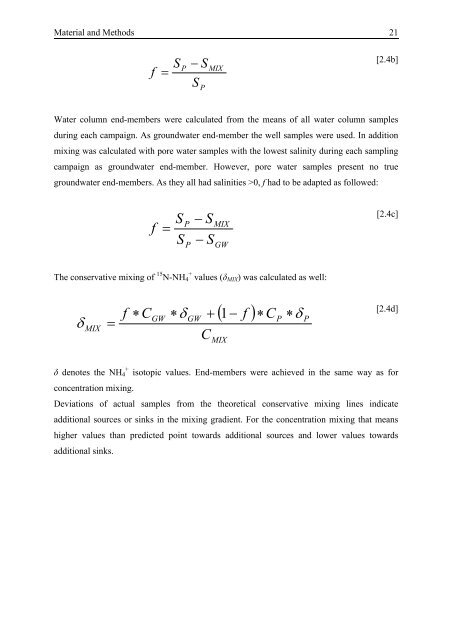Poland - IOW
Poland - IOW
Poland - IOW
You also want an ePaper? Increase the reach of your titles
YUMPU automatically turns print PDFs into web optimized ePapers that Google loves.
Material and Methods 21<br />
f<br />
=<br />
S<br />
P<br />
− S<br />
S<br />
P<br />
MIX<br />
[2.4b]<br />
Water column end-members were calculated from the means of all water column samples<br />
during each campaign. As groundwater end-member the well samples were used. In addition<br />
mixing was calculated with pore water samples with the lowest salinity during each sampling<br />
campaign as groundwater end-member. However, pore water samples present no true<br />
groundwater end-members. As they all had salinities >0, f had to be adapted as followed:<br />
f<br />
=<br />
S<br />
S<br />
P<br />
P<br />
− S<br />
− S<br />
MIX<br />
GW<br />
[2.4c]<br />
The conservative mixing of 15 N-NH 4 + values (δ MIX ) was calculated as well:<br />
δ<br />
MIX<br />
=<br />
f<br />
∗C<br />
GW<br />
∗δ<br />
GW<br />
+<br />
C<br />
( 1−<br />
f )<br />
MIX<br />
∗C<br />
P<br />
∗δ<br />
P<br />
[2.4d]<br />
δ denotes the NH + 4 isotopic values. End-members were achieved in the same way as for<br />
concentration mixing.<br />
Deviations of actual samples from the theoretical conservative mixing lines indicate<br />
additional sources or sinks in the mixing gradient. For the concentration mixing that means<br />
higher values than predicted point towards additional sources and lower values towards<br />
additional sinks.
















